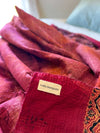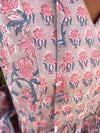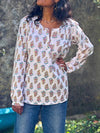
In the arid lands of Gujarat, where every grain of sand tells a story thousands of years old, traditional embroidery is more than just an art. It is a way of life, a transmission from soul to soul, a link between the past and the future. The embroidery of Gujarat's communities—Rabari, Jat, Mutava—is a vibrant heritage, imbued with symbolism, cultural pride, and ancestral know-how.
Rabari: the embroidery of the nomads, a silent language of freedom
The Rabari community, whose nomadic origins span centuries, has developed a unique art of embroidery that reflects life in the desert, the freedom of wide-open spaces, and the stories of their culture. Their embroidery is recognizable by its powerful geometric patterns, mystical spirals, and stylized representations of nature. Each stitch is a reflection of their identity: free, bold, and deeply connected to the land. The women embroider vibrant works of inlaid mirrors onto cotton and wool fabrics, symbolizing the light of the desert and protection against the evil eye. These mirrors, interwoven with brightly colored threads—red, black, and white—transform each piece into a living talisman, a visual echo of their spiritual connection to nature.
Jat: precision and cultural diversity
Jat embroidery, created by the Muslim communities of Gujarat, is of unparalleled finesse and richness. The motifs, often inspired by Islamic architecture and natural elements, are impressively complex. Jat women have mastered the art of detail and demonstrate infinite patience: they use tiny stitches which, when combined, form elegant and harmonious repeating patterns. Jat embroidery is distinguished by its deep colors, often in harmony with the earth and sky of Gujarat, creating a striking contrast between the meticulous detail and the vastness of the fabric.
Mutava: the soul of the artisans of the desert's edge
The Mutava people of Kutch, living in remote regions, have perfected a unique style of embroidery. Using geometric and floral motifs, often inspired by their environment and way of life, they create works imbued with sacred and protective symbols. Mutava embroideries, with their small mirror inlays and intricate patterns, express stories hidden in every stitch. The colorful threads, woven in delicate harmony, tell legends of their ancestors and protect their way of life from the inexorable passage of time. Each piece of Mutava embroidery is not only a visual masterpiece but also a talisman. The protective motifs, fertility symbols, and animal or floral designs all bear witness to the profound connection between these artisans and their environment.
These embroidery techniques are a heritage to be protected
These forms of Gujarat embroidery – Rabari, Jat, Mutava, and many others – embody a profound connection between the artisan and the material, a fusion of history, spirituality, and know-how passed down from generation to generation. Each stitch is an act of resistance against oblivion, a celebration of the culture and identity of these communities.
In a world where mass production threatens to erode these traditions, Gujarat embroidery is a living treasure, a world heritage that exudes strength, resilience, and cultural pride. It embodies the power of handmade craftsmanship with works of art to wear, pass on, and celebrate. in a world that tends towards oblivion.




0 comments